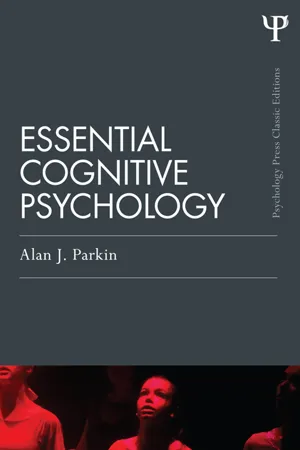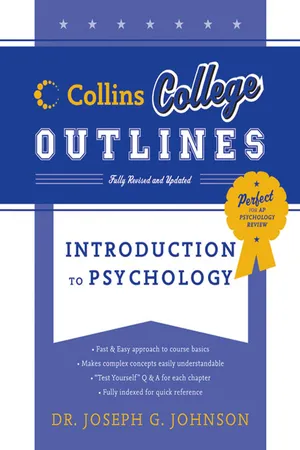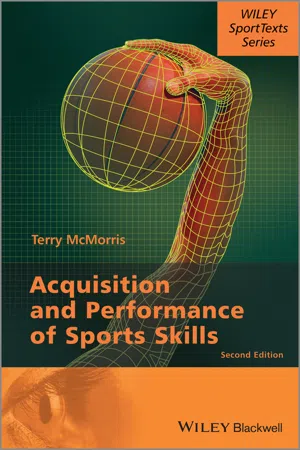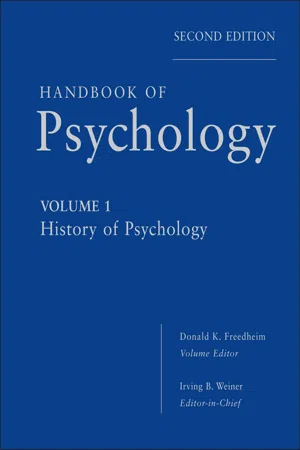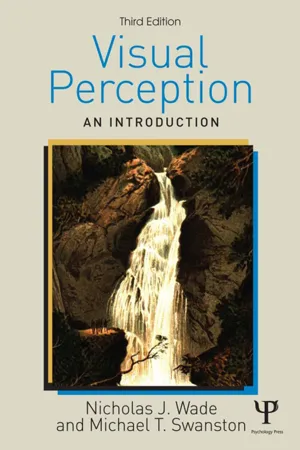Psychology
Perception Research
Perception research in psychology focuses on understanding how individuals interpret and make sense of sensory information from the environment. It explores the processes involved in organizing and interpreting sensory input to form meaningful perceptions. This field investigates various factors that influence perception, such as attention, memory, and individual differences, to gain insights into human cognition and behavior.
Written by Perlego with AI-assistance
Related key terms
11 Key excerpts on "Perception Research"
- eBook - ePub
- Alan J. Parkin(Author)
- 2014(Publication Date)
- Psychology Press(Publisher)
Cognitive psychologists have been very uneven in the time they have devoted to the study of our senses. Most work has been carried out on our visual system because of the dominant role it plays in communication. Next comes hearing, followed by touch, smell and taste. Research into hearing has been quite substantial owing to the need to understand speech perception but the other three senses have received relatively little attention. However, research into touch (often known as haptic perception) has received considerable impetus from its relevance to communication aids for the blind. Smell and taste, although subject to some investigation within cognitive psychology, have been of more interest to physiologists. In this book we will be primarily concerned with visual perception (this chapter) and with hearing in relation to speech perception (Chapter 10). Visual perception is more than a “cognitive photograph” The first thing to learn about visual perception, and indeed all other forms of perception, is that it is reconstructive. The visual percept which we experience as reality does not come about in a manner analogous to the way in which a visual image develops passively in the emulsion of a film. Rather, a visual percept is built up by a wide range of inferential processes which use cues provided by the basic two-dimensional input on the retina. This creates a perceptual reality of three dimensions in which, as we shall see, a constant world is maintained despite considerable distortions in what projects on to the retina. FIG. 2.1. What do you see here? (answer on next page). The reconstructivist view of perception introduces us to a crucial distinction which runs right through a wide range of explanations in cognitive psychology. This is the distinction between bottom-up and top-down processing (note that the terms data-driven and conceptually-driven are often used as alternatives) - eBook - ePub
- Alan J. Parkin(Author)
- 2013(Publication Date)
- Psychology Press(Publisher)
Cognitive psychologists have been very uneven in the time they have devoted to the study of our senses. Most work has been carried out on our visual system because of the dominant role it plays in communication. Next comes hearing, followed by touch, smell, and taste. Research into hearing has been quite substantial owing to the need to understand speech perception but the other three senses have received relatively little attention. However, research into touch (often known as haptic perception) has received considerable impetus from its relevance to communication aids for the blind. Smell and taste, although subject to some investigation within cognitive psychology, have been of more interest to physiologists. In this book we will be primarily concerned with visual perception (this chapter) and with hearing in relation to speech perception (Chapter 10). Visual perception is more than a ‘cognitive photograph’ The first thing to learn about visual perception, and indeed all other forms of perception, is that it is reconstructive. The visual percept which we experience as reality does not come about in a manner analogous to the way in which a visual image develops passively in the emulsion of a film. Rather, a visual percept is built up by a wide range of inferential processes which use cues provided by the basic two-dimensional input on the retina. This creates a perceptual reality of three dimensions in which, as we shall see, a constant world is maintained despite considerable distortions in what projects on to the retina. The reconstructivist view of perception introduces us to a crucial distinction which runs right through a wide range of explanations in cognitive psychology. This is the distinction between bottom-up and top-down processing (note that the terms data-driven and conceptually-driven are often used as alternatives). A bottom-up process is one which proceeds from lower levels of analysis to higher levels - eBook - ePub
- Ann L. Weber, Joseph Johnson(Authors)
- 2011(Publication Date)
- Collins Reference(Publisher)
CHAPTER 6Perception
P erception is usually taken to mean the final, organized, and meaningful experience of sensory information. The difference between sensation and perception is one of degree of understanding. Sensation (from a Latin word meaning “to feel”) involves the neural stimulation of sensory systems by physical changes, as we saw in Chapter 5. Perception (from the Latin per or “thorough” and capio or “grasp”) involves recognizing the meaning of what has been sensed. Basically, sensation is detecting a stimulus, whereas perception is recognizing a stimulus. That is, when one senses a stimulus, one is aware of it, but when one perceives that stimulus, one understands what it is.STUDYING PERCEPTIONThe study of perception has been guided by different approaches to exactly what the nature of perception is. To a large degree, the study of perception has also been defined by the formal quantitative framework used to analyze perceptual performance. These concepts are introduced here to lay the foundation for the remainder of the chapter.Approaches to PerceptionThere are three primary approaches that describe psychologists who study perception. The ecological approach, founded by James J. Gibson (1904–1979), focuses on the interactions with the environment, in particular how we perceive the cues in the environment that help us to perform specific actions. The constructivist approach is mainly concerned with perceptual inference, or how we use incomplete sensory information to form mental representations. These approaches have contributed a great deal to the more recent computational approach, which attempts to understand the exact computations that a perceptual system performs.Psychophysics RevisitedWe discuss a bit about the historical contributions of psychophysics in Chapter 1 and the application of psychophysics to sensation in Chapter 5. Classical psychophysical studies have examined absolute thresholds - eBook - ePub
Sports Psychology
Concepts and Applications
- S. K. Mangal, Shubhra Mangal(Authors)
- 2023(Publication Date)
- Routledge India(Publisher)
Perception provides the necessary link in terms of process for converting input into output by organising and interpreting the sensory impressions. Perception is the information extractor: Our sensory receptors are bombarded continuously by various stimuli present in our environment. It is impossible to react to all stimulation. A selection process is therefore essential. Perception performs this duty by extracting relevant information out of a jumble of sensory impressions and converting it into some meaningful pattern. Perception is preparation to respond: Perception is the first step toward the active behaviour of an organism. It is the stage that prepares an individual for action and response. Our sensory receptors are just the receiving and transmitting centres of the sensory information. How we should react and respond is ordered by our central nervous system through the involvement of some mediating activity known as perception. Perception involves sensation: In a simple and straightforward way, we may sense that sensation precedes perception. The relationship between sensation and perception is always direct: that is, what we have in sensation is always a part of perception. Perception goes beyond sensation as it organises, interprets, and gives meaning to the results of sensations. Therefore, to a student of psychology, perception means assigning meaning to sensory stimuli. Sensation attached to meaning is thus termed perception. Perception provides organisation: In addition to the help provided in deriving meaning from sensory impressions, perception also helps in their proper arrangement and organisation. This arrangement or organisation reflects a particular pattern rather than being merely a summation of the sensory impressions. What one perceives, they perceive as a whole in an organised pattern and not as the sum total of various stimuli. Perception is highly individualised: Perception is an individual affair - eBook - ePub
- Terry McMorris(Author)
- 2014(Publication Date)
- Wiley(Publisher)
The organization, integration and interpretation of sensory information is thought to take place primarily in the prefrontal cortex, but it draws upon the sensory information held in the specific sensory areas of the cortex and information from LTM contained in several areas of the brain. It should, therefore, be of no surprise to find that fMRI and PET studies have shown considerable activation of the prefrontal cortex during perceptual tasks. The parietal cortex has also been shown to play a role in perception and is particularly active in tasks where the individual switches attention for one part of the display to another, for example, a defender in hockey switching between attending to her/his immediate opponent and the runs of other attackers.Definition of perception
Based on the above, we can define perception, according to information processing theory, as being the organization, interpretation and integration of sensory information. Kerr (1982) provides a similar definition but includes the word ‘conscious’. Although information processing theorists would argue that, most of the time, perception is a conscious process, recent research on learning and anticipation has shown that it can take place at a subconscious level.Signal detection theory
As information processing theorists claim that perception is inferred, a number of theories have been developed to explain different aspects of the cognitive processes taking place. One of the first theories was Swets’ (1964; Swets and Green, 1964) signal detection theory. Swets realized that people live in an environment that is full of sensory information. He reckoned that the individual receives over 100 000 signals per second. These may be signals from the environment and/or from within the person themselves. Sport provides many examples of this and the problems it can cause. Think of a tennis player about to serve in a game on Centre Court at Wimbledon. What kinds of signals do you think the player will be receiving visually and auditorally? What kinds of internal signals might the player be receiving: e.g. will I win, will I play well? The problem facing Swets was how to explain how anyone can recognize relevant information against this background of signals, which he termed ‘noise - eBook - ePub
- (Author)
- 2012(Publication Date)
- Wiley(Publisher)
Fortunately, a broad overview shows that it is possible to see some unifying perspectives that have evolved through the history of the study of perception and are not bound to any single sensory modality. This seems to have been recognized by many researchers in this area, since it is not uncommon for them to do research on several sensory systems at the same time. Thus, we find Helmholtz and Hering studying both vision and audition, and Georg von Békésy, who won the Nobel Prize for his work on hearing, also did research on vision and touch. When it comes to theorists, Fechner, Stevens, Ames, Gibson, Wertheimer, Koffka, Helson, and others have presented frameworks, models, and mechanisms that are virtually modality independent, and can be tested and applied to vision, hearing, or any other sensory system. This is not to deny that there are issues that are important to particular single sensory modalities that do not generalize. For example, the chain of events that leads from the absorption of a photon to a visual neural response and ultimately to a conscious recognition of the stimulus seems to be unique to vision. Instead, I am suggesting that there are global theoretical and methodological frameworks that encompass all sensory and perceptual research. To refer back to that very specific issue of visual detection, while the mechanism of how a photon is captured is specific to sight, all sensory modalities must deal with the idea of detection, which includes the idea of sensory thresholds and their relationship to what the individual consciously perceives. It is also likely that the higher level decisional processes, where the observer must decide if a stimulus is there or not, will be the same whether one is dealing with vision, audition, olfaction, or any other sensory system. Thus, we find that there are certain common issues and definitions that cut across all sensory modalities. These methods, philosophical foundations, and psychological understandings have undergone a steady evolution during the history of this area of psychological research.This chapter is written as an overview and concentrates on some general themes, rather than on the data and findings from any one sensory modality. From this, hopefully, some idea of the context and scope of the study of perception, and its relationship to other aspects of psychology and other sciences, will emerge. Three global issues will reappear many times and in several guises during this history. The first deals with the perceptual problem, which is really the issue of the correspondence (or noncorrespondence) between our internal representation of the environment in consciousness and the objectively measured external physical situation. The second has to do with the borrowing of methods, viewpoints, and theoretical formulations from other sciences, such as physics and physiology. The third is the distinction between sensation and perception, which is really the distinction between stimulus-determined aspects of conscious and interpretive or information-processing contributions to the conscious perceptual experience.The Perceptual Problem
We must begin our discussion with some philosophical considerations. This is not merely because all of science began as philosophy, nor because up until the middle of the 20th century, philosophy and psychology departments were often combined as the same academic entity in many universities. The reason that we begin with philosophy is because it takes a shift in philosophical viewpoint to justify why we need a psychological discipline to study sensation and perception in the first place. Most people have a naïve, realistic faith in the ability of our senses to convey an accurate picture of the world to us. For the proverbial “man on the street,” there is no perceptual problem. You open your eyes and the world is there. According to this viewpoint, we perceive things the way that we do because that is the way that they are. We see something as a triangular shape because it is triangular. We feel roughness through our sense of touch because the surface is rough. Thomas Reid, a Scottish philosopher who will later prove to be very significant in the history of perception, summarized this idea in 1785 when he wrote: - eBook - ePub
Social Interaction
Process and Products
- Michael Argyle(Author)
- 2017(Publication Date)
- Routledge(Publisher)
IV Perception of the other during InteractionIntroduction and Methods
Person perception has been extensively studied in recent years, and several good accounts of this work are available (e.g. Tagiuri, 1969; Smith, 1967). Much of the research has taken person perception as a primarily cognitive problem, rather akin to concept-formation or problem-solving - and of course these processes are important here. In this chapter we will look instead at person perception as something that happens during social interaction, and which is a very important part of such interaction. Thus we shall be concerned with what perceptual information is needed by an interactor, how it is obtained, and the fact that the 'judge' is simultaneously being perceived by the other person. We shall also broaden the range of perceptual data beyond facial expression, which has often been the object of research in this field, to include tones of voice, and the whole range of verbal and non-verbal behaviour discussed in the last chapter. The term 'perception' is used here in somewhat different sense from the way it is used in experimental psychology. We are not concerned with whether A perceives B to be short or tall, dark or fair, but with A's inferences about B's personality, emotional state, attitudes to himself, and so on. In other words we are concerned with inferences about another person based on his visible or audible behaviour.The perception of persons is a more complex matter than the perception of other physical objects, since the sensory inputs are normally obtained as part of the process of interaction; there are two main channels of information, visual and auditory, and both are open intermittently - the other speaks for only part of the time, emitting verbal and non-verbal noises, and the judge can look for relatively short intervals. Inferences are made because they are needed by each interactor, and the kind of inferences made depend on the situation and the relationship between the interactors. The other person is seen, not only as an object of perception, but as another centre of conscious experiences and intentions and as a perceiver himself. - eBook - ePub
Visual Perception
An Introduction, 3rd Edition
- Nicholas Wade, Mike Swanston(Authors)
- 2013(Publication Date)
- Psychology Press(Publisher)
By emphasising the visual dimension of our environmental interactions in this book, we do not wish to suggest that vision operates in isolation from other senses. It is clearly insufficient to study vision alone, as all our senses are intimately integrated, and we have a unified perception of external objects. Perception engages all the senses, but we possess the unique ability to express our perceptual experiences through language, which tends to reflect the operation of particular senses. Thus, it might seem from the way we speak about perception as though the senses work in isolation rather than in concert. The vocabulary devoted to each of the senses is not evenly distributed either. Vision has the lion’s share of words as well as the work associated with our perceptual experiences.Human senses are linked to an intricately organised brain, which has evolved to do more than simply identify and act on the necessities for survival. Humans not only use their senses to survive; they also reflect on their experience through language and thought. Through language, we know that our own and other people’s perception of the world is generally stable: objects have positions, shapes, and colours that we seem to be conscious of instantly, and we can reach for them or move to where they are, without any apparent effort. We can recognise small differences between objects and we can categorise or name them appropriately. Some objects, like food, will be particularly significant for our survival, and we learn how to recognise them from all sorts of positions. Perceiving the location of objects and recognising them is achieved regardless of whether we, or the objects themselves, are stationary or moving. Clearly, there is some process within us that gives rise to our experience of visual perception and the behaviour that it guides. It is not surprising that throughout history students of the senses have found it fascinating to speculate what this might be.What we call ‘perception’is an experience that normally results from stimulation of the senses by the environment. Perceptions can also arise through hallucination through dreaming, abnormal brain function or the use of drugs. However, our aim is to describe the characteristics of perception in its normal mode of operation, which has evolved to support interaction with the world around us. Perception can be examined in a variety of ways, such as describing our experiences verbally or measuring them by psychophysical experiment; it can also be related to the processes in the nervous system that accompany such experiences. Nerve impulses in the sensory nerves are relayed to the brain and behaviour, including speech, usually results from this sequence of events. Traditionally the only records of action of the senses were provided by behaviour but now a wide range of indirect physiological measures can augment them. In humans the range of behaviours is broad and includes describing the experiences initiated by sensory stimulation and the links it might have with previous stimulations. We refer to these as observations and we associate them with verbal descriptions. Observations provide the bedrock of perception and of other actions of the brain. Historical records of observation precede records of their verbal descriptions; that is, the products of art precede those of writing, by many thousands of years. Relatively little is known about the origins of visual art: examples of marks made on tools and cave walls have been dated to tens of thousands of years ago, but we do not know when such activities began. We assume that the cave-dwellers saw their world in much the same way as we see ours. It is not perception that has changed, but the world in which it takes place. - eBook - ePub
Perspectives on Memory Research (PLE:Memory)
Essays in Honor of Uppsala University's 500th Anniversary
- Lars-Göran Nilsson(Author)
- 2014(Publication Date)
- Psychology Press(Publisher)
The sources of data for the memorial system differ considerably. Two sources can be identified: internal and external. Much of the information within our memory structures originated externally with the perceptual analysis and indeed is the stored representation of that analysis. In addition, human thought processes can operate upon both perceptual data and memorial data to produce new conceptualizations that can themselves be stored within memory: This is an internal source of data. Most modern approaches to the study of memory assume that only interpretations of arriving sensory data are stored within memory (as opposed to storage of raw, uninterpreted data). Hence, perceptual information stored within memory differs considerably from sensory data that arrive at the organism. The difference lies in the interpretive, constructive nature of perception.It might be possible to characterize the process of perception as that of providing interpretation to the arriving sensory information. In similar fashion, one might characterize the process of memory as that of recovering those interpretations.Cognitive Science
This chapter has touched briefly upon a number of different areas, with special emphasis on representation and processing. I wish to conclude by speculating about the direction of research in future years within psychology.Recently, a faculty colleague commented on a paper on representation (Palmer, 1977) that he didn’t understand what the issue was; the paper did not lead to any new experiments. His criterion of value in psychology, he told me, was how many good experiments an idea will induce.I disagree fundamentally with this criterion. I want to judge an idea by how much new understanding I get, not how many experiments I can do. Experiments that do not bear upon important issues have negligible value, for they detract from the proper pursuit of understanding. Experiments should be pursued with a purposeful goal in mind, a goal that leads to increased understanding.We know very little about cognitive functions and of the mechanisms that might be responsible. We know little about intelligence or about the general class of intelligent mechanisms and systems. I believe that psychology will not make progress until it learns to ask the correct questions and that this will not occur until we learn more about the properties of intelligence and cognition in general. Thus, I would like to see a new science of cognition, one that deals with all cognitive proceses—whether real or imaginary, concrete or abstract, human or machine. I want to understand what it takes to be intelligent. What processes can perform what operations? What are the limits and powers of different representations and processing structures? I need to understand the range of possibilities in order to tackle the problem of discovering the cognitive structures of the human in an effective, informed way. - eBook - ePub
Cross-Cultural Psychology
Critical Thinking and Contemporary Applications, Sixth Edition
- Eric B. Shiraev, David A. Levy(Authors)
- 2016(Publication Date)
- Routledge(Publisher)
a priori; they must experience everything right before their own eyes. Referring to his own ancestors, he said Africans, on the other hand, are different because of environmental conditions in Africa that required them to rely mostly on hearing and touch. They felt objects and vibrations through their skin, without visual verification by the eyes; they could express themselves through their voices. Albert then suggested that, due to such perceptual differences between European and African ancestors, European Americans are more likely to succeed in engineering, science, and writing, whereas African Americans tend to excel at playing music, singing, and other nonvisual activities. “Do you have any evidence to support your idea?” his fellow student asked. “How can you verify this?” he continued. “I can’t. I simply feel this way!” responded Albert, laughing at his own answer.Was Albert justified in daringly suggesting the sensory differences between Africans and Europeans and attributing them to each group’s differing environmental conditions? Are there any significant sensory differences among people of various cultural groups? Or do people see, hear, and feel the physical world in the same way? If not, what particular characteristics of vision, hearing, smell, touch, or taste have the strongest cultural roots? From a more practical standpoint, should fashion designers pay attention to certain colors either liked or disliked by a particular ethnic or national groups? Do pilots in all countries prefer to scan their control board from left to right? How do cultures affect our consciousness? How do people interpret their dreams? We will address these and other questions throughout this chapter, as we explore sensation, perception, consciousness, and other things through the examination of cross-cultural aspects of human cognition, acquiring knowledge and understanding through experience.Sensation and Perception: Basic Principles
The process by which receptor cells are stimulated and transmit their information to various brain centers is called sensation. Whether you see a moving bright light in the evening sky or taste a spicy pickle in your mouth, all sensations begin from a signal or stimulus, either external or internal, in the form of energy capable of exciting the nervous system. Sensation converts external energy into an internal neurophysiological process, which “results” in a particular psychological experience: We see the moving light and taste the piece of food. Do we detect every stimulus? Obviously not, because certain stimuli are not experienced at all. The minimum amount of physical energy needed for an individual to notice a stimulus is called an absolute threshold. The difference threshold is the lowest level of stimulation required to sense that a change in the stimulation has occurred. Sensory adaptation - eBook - ePub
- Simon Bell(Author)
- 2012(Publication Date)
- Routledge(Publisher)
Language is one of the main uses of sound, but we tend to convert words into images before we can make full use of them. Sight, by comparison, not only permits a much greater variety of information to be received, but it leads directly to the means by which we think and express ourselves. In this respect, the sensory input about the world is much more than mechanical reception of data, later processed by the brain as a separate activity. For example, at the same time as we perceive the world, we also project our subjective feelings and preconceptions onto it. This is why concepts such as ‘landscape’ or ‘wilderness’ are as much states of mind as they are physical entities; this fact has major implications for aesthetics, and for the meaning of the term ‘environment’ (see Chapter Three).The eye may, in some respects, be constructed and function like a camera but, being directly connected to the brain, it also interacts with the mental processes that use it. Most of us rely so much on a constant flow of sensory information that if deprived of it, perhaps by being shut in an empty, dark and soundless room for a period, the mind would start to supply images to fill the void. The extreme results of this would be hallucinations. Hence, it is clear that perception is not just the passive reception of information.Blind people are excluded from the perception of the world available to the sighted. However, they compensate by developing the other senses, especially touch, to much greater degrees than most people. Similar compensations occur for those who cannot hear or speak. The extent to which the ‘mind’s eye’ exists for blind people, especially those blind from birth, is difficult for sighted people to appreciate.The rest of this chapter will concentrate on vision, because it is so important, as a perception and a thinking medium for most people. In order to understand visual perception, we must know something of the physiology and psychology of the mechanisms involved. Recent research is uncovering much about the detailed processes of image formation and the way in which the brain cells build up an image of the world. An extremely helpful synthesis has been written by the British team of Vicki Bruce, Patrick Green and Mark Georgeson, from which much of the following discussion is sourced.
Index pages curate the most relevant extracts from our library of academic textbooks. They’ve been created using an in-house natural language model (NLM), each adding context and meaning to key research topics.

